engine FORD E SERIES 1997 4.G Workshop Manual
[x] Cancel search | Manufacturer: FORD, Model Year: 1997, Model line: E SERIES, Model: FORD E SERIES 1997 4.GPages: 192, PDF Size: 3.44 MB
Page 148 of 192
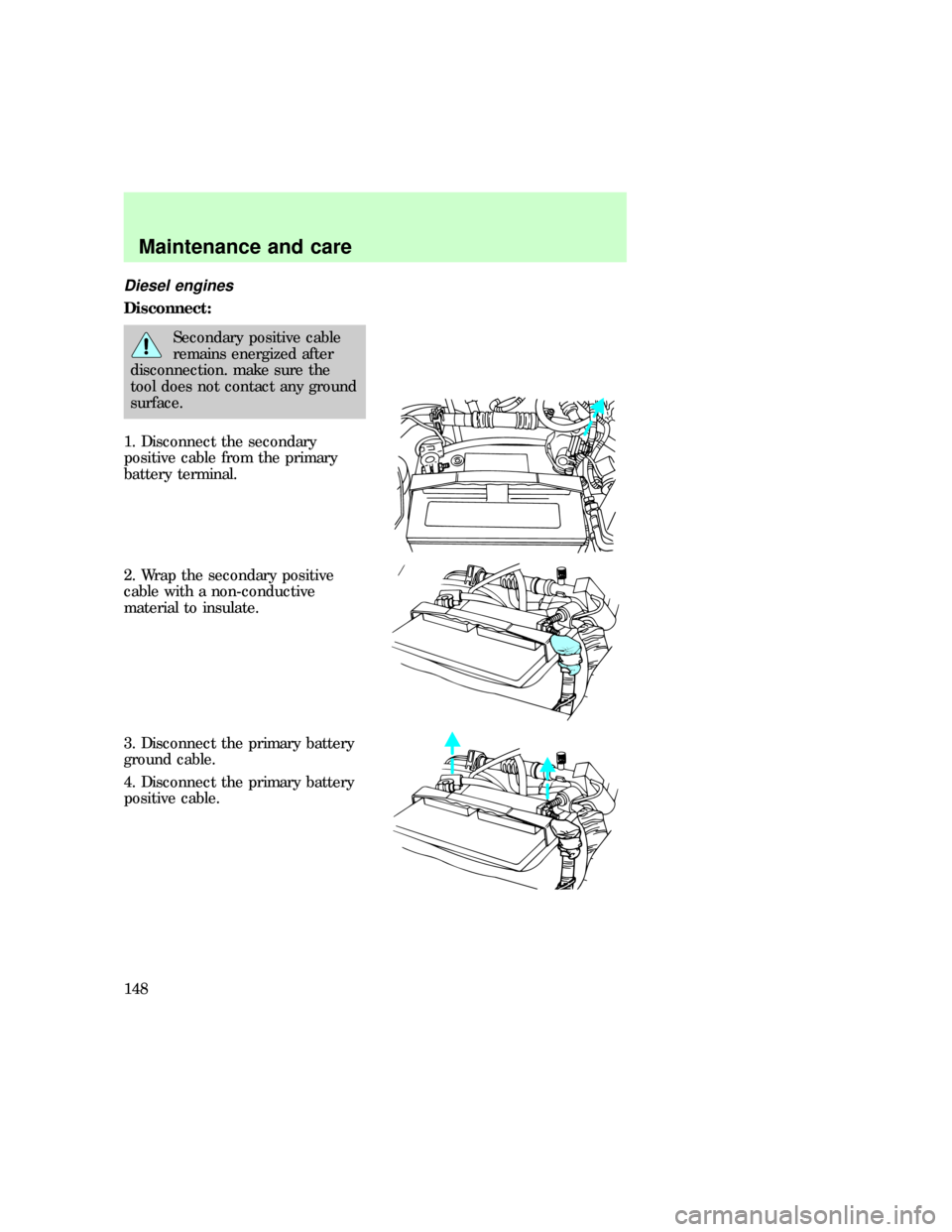
Diesel engines
Disconnect:
Secondary positive cable
remains energized after
disconnection. make sure the
tool does not contact any ground
surface.
1. Disconnect the secondary
positive cable from the primary
battery terminal.
2. Wrap the secondary positive
cable with a non-conductive
material to insulate.
3. Disconnect the primary battery
ground cable.
4. Disconnect the primary battery
positive cable.
Maintenance and care
148
Page 159 of 192
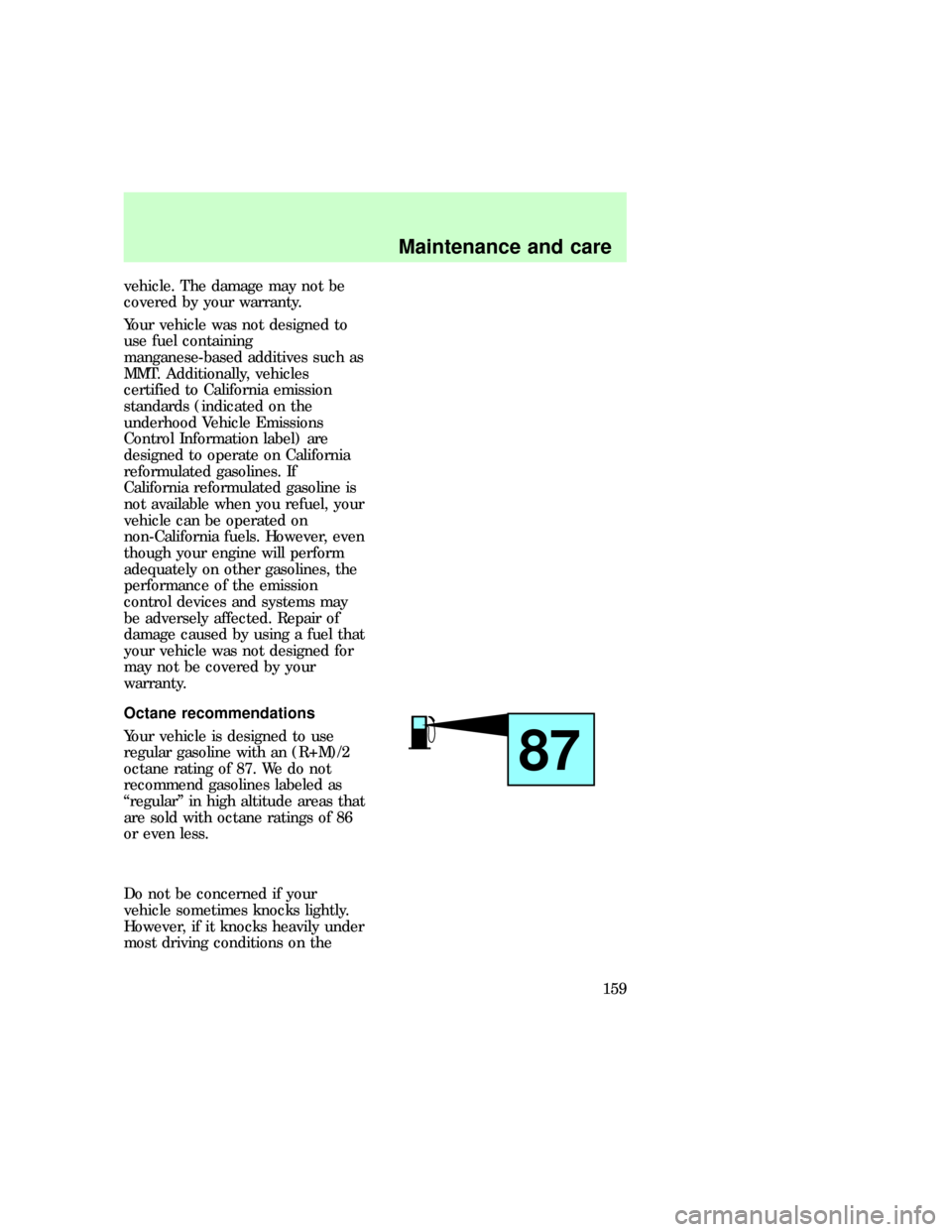
vehicle. The damage may not be
covered by your warranty.
Your vehicle was not designed to
use fuel containing
manganese-based additives such as
MMT. Additionally, vehicles
certified to California emission
standards (indicated on the
underhood Vehicle Emissions
Control Information label) are
designed to operate on California
reformulated gasolines. If
California reformulated gasoline is
not available when you refuel, your
vehicle can be operated on
non-California fuels. However, even
though your engine will perform
adequately on other gasolines, the
performance of the emission
control devices and systems may
be adversely affected. Repair of
damage caused by using a fuel that
your vehicle was not designed for
may not be covered by your
warranty.
Octane recommendations
Your vehicle is designed to use
regular gasoline with an (R+M)/2
octane rating of 87. We do not
recommend gasolines labeled as
ªregularº in high altitude areas that
are sold with octane ratings of 86
or even less.
Do not be concerned if your
vehicle sometimes knocks lightly.
However, if it knocks heavily under
most driving conditions on the
87
com_octane_recommendations.01
Maintenance and care
159
Page 160 of 192

recommended octane fuel, see
your dealer or a qualified service
technician to prevent any engine
damage.
Fuel quality
If you are experiencing starting,
rough idle or hesitation problems
try a different brand of fuel. If the
condition persists, see your dealer
or a qualified service technician.
The American Automobile
Manufacturers Association (AAMA)
issued a gasoline specification to
provide information on high quality
fuels that optimize the
performance of your vehicle. We
recommend the use of gasolines
that meet the AAMA specification
if they are available.
It should not be necessary to add
any aftermarket products to your
fuel tank if you continue to use a
high-quality fuel.
Cleaner air
Ford approves the use of gasolines
to improve air quality, including
reformulated gasolines, that
contain oxygenates such as a
maximum of 10% ethanol or 15%
MTBE. There should be no more
than 5% methanol with cosolvents
and additives to protect the fuel
system.
Calculating fuel economy
To accurately calculate your
vehicle's fuel economy:
com_fuel_quality.01
com_cleaner_air.01
com_calculating_economy.01
Maintenance and care
160
Page 161 of 192

1. Fill the tank completely and
record the initial odometer
reading.
2. Each time you fill the tank,
record the amount of fuel added
(in liters or gallons).
3. After at least three to five fuel
tank fill-ups, fill the fuel tank and
record the current mileage
reading.
4. Use one of the following
equations to calculate fuel
economy.
Liters used x 1004Total
kilometers traveled
Total miles traveled4Total
gallons used
Keep a record for at least one
month. This will provide an
accurate estimate of the vehicle's
fuel economy.
WHAT YOU SHOULD KNOW
ABOUT THE EMISSION
CONTROL SYSTEM
Your vehicle is equipped with a
catalytic convertor which enables
your vehicle to comply with
applicable exhaust emission
requirements. For more
information on your vehicle's
emission control system, see the
Vehicle Emission Control
Information decal located on the
left side of the engine
compartment.
Follow these guidelines to ensure
proper emission system operation:
eco_emission_control
Maintenance and care
161
Page 162 of 192
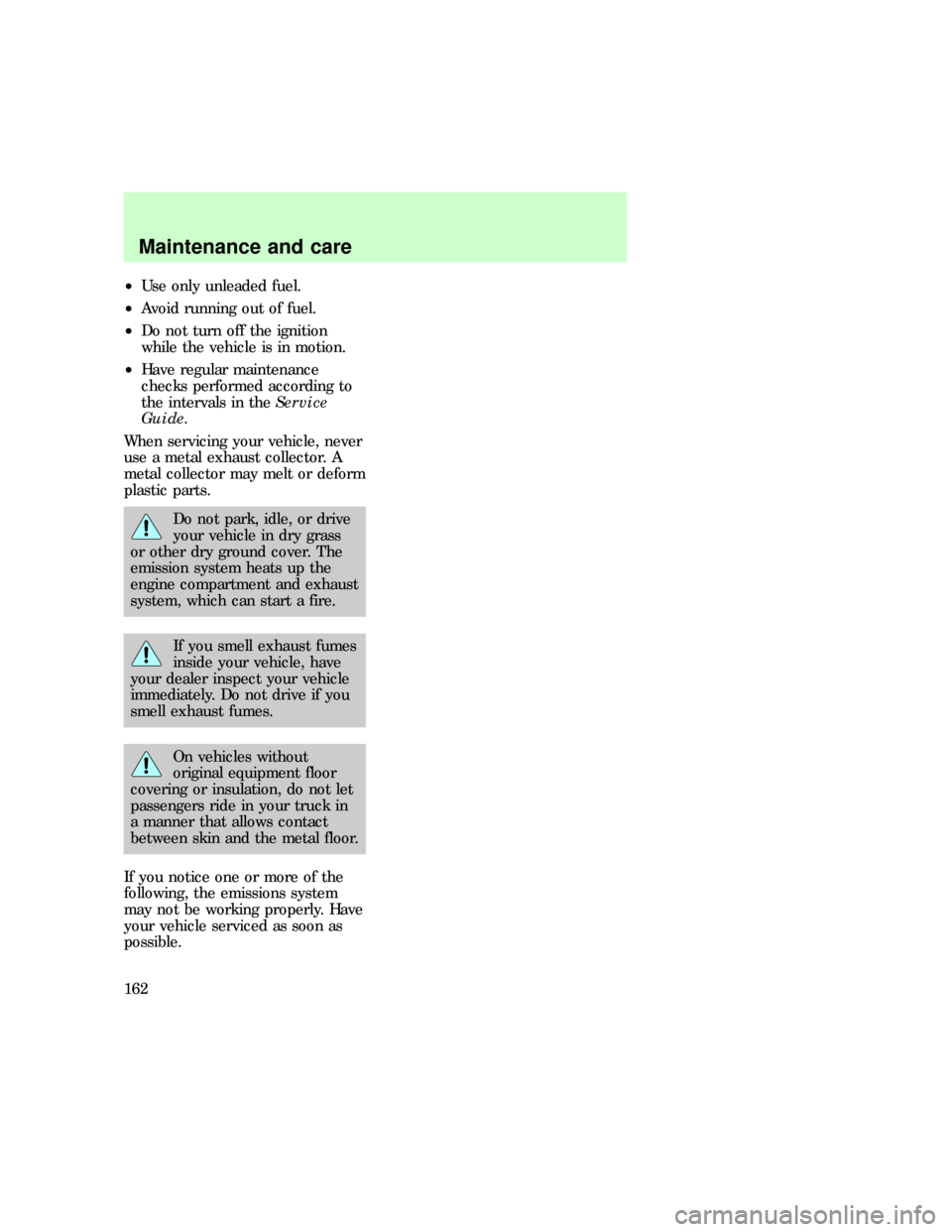
²Use only unleaded fuel.
²Avoid running out of fuel.
²Do not turn off the ignition
while the vehicle is in motion.
²Have regular maintenance
checks performed according to
the intervals in theService
Guide.
When servicing your vehicle, never
use a metal exhaust collector. A
metal collector may melt or deform
plastic parts.
Do not park, idle, or drive
your vehicle in dry grass
or other dry ground cover. The
emission system heats up the
engine compartment and exhaust
system, which can start a fire.
If you smell exhaust fumes
inside your vehicle, have
your dealer inspect your vehicle
immediately. Do not drive if you
smell exhaust fumes.
On vehicles without
original equipment floor
covering or insulation, do not let
passengers ride in your truck in
a manner that allows contact
between skin and the metal floor.
If you notice one or more of the
following, the emissions system
may not be working properly. Have
your vehicle serviced as soon as
possible.
Maintenance and care
162
Page 163 of 192
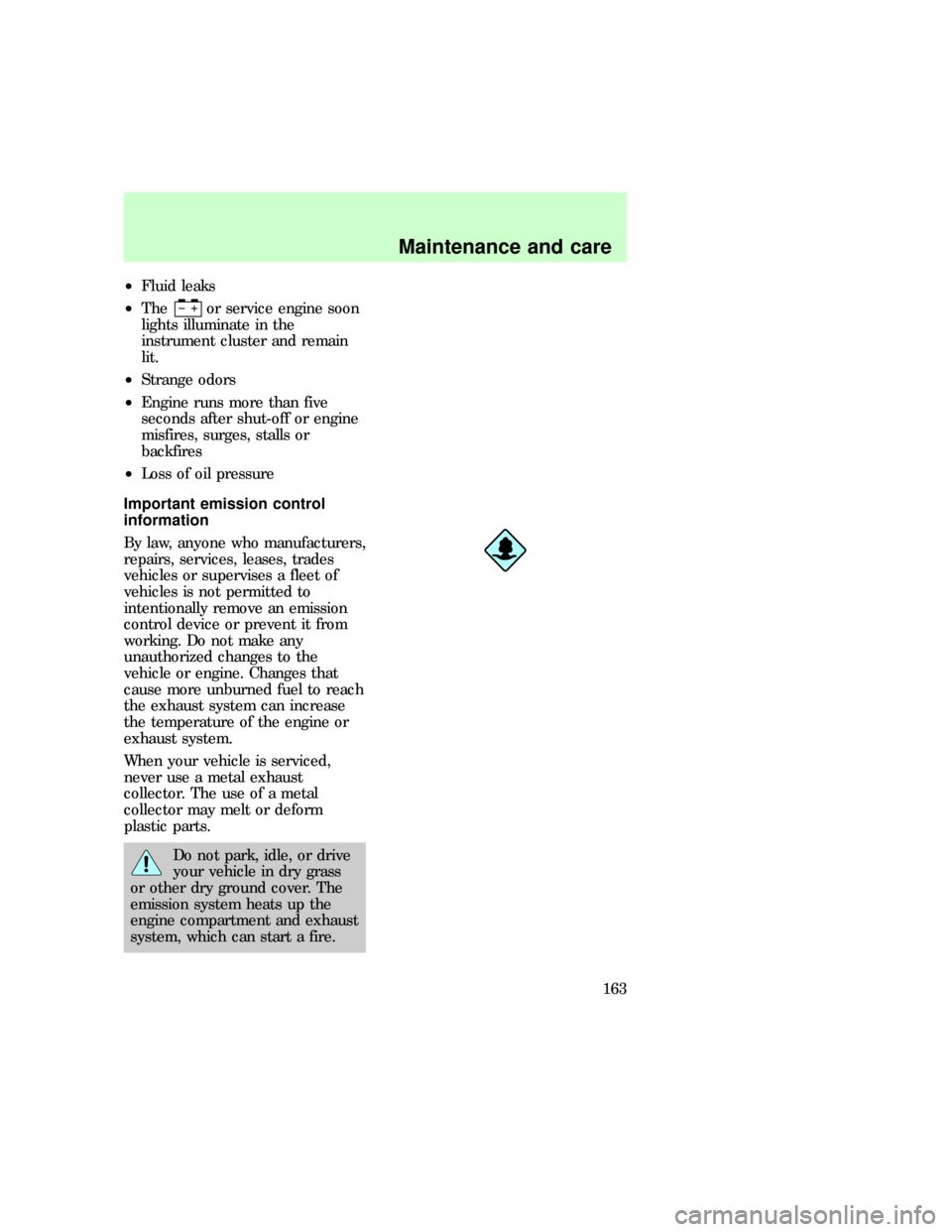
²Fluid leaks
²The
or service engine soon
lights illuminate in the
instrument cluster and remain
lit.
²Strange odors
²Engine runs more than five
seconds after shut-off or engine
misfires, surges, stalls or
backfires
²Loss of oil pressure
Important emission control
information
By law, anyone who manufacturers,
repairs, services, leases, trades
vehicles or supervises a fleet of
vehicles is not permitted to
intentionally remove an emission
control device or prevent it from
working. Do not make any
unauthorized changes to the
vehicle or engine. Changes that
cause more unburned fuel to reach
the exhaust system can increase
the temperature of the engine or
exhaust system.
When your vehicle is serviced,
never use a metal exhaust
collector. The use of a metal
collector may melt or deform
plastic parts.
Do not park, idle, or drive
your vehicle in dry grass
or other dry ground cover. The
emission system heats up the
engine compartment and exhaust
system, which can start a fire.
eco_emission_info
eco_i-m_testing
Maintenance and care
163
Page 164 of 192

Preparing your vehicle for
inspection/maintenance (I/M)
testing
In some localities it may be a legal
requirement to pass an I/M test of
the on-board diagnostic (OBD) II
system. If your vehicle's powertrain
system or battery has just been
serviced, the OBD II system is
reset to a condition unready for
I/M testing. To ready the OBD II
system for I/M testing, the law
specifies that additional city and
highway driving is necessary to
complete the check of the OBD II
system.
The driving modes required to
reach the ready condition consist
of a minimum of 30 minutes of city
and highway driving:
²At least 20 minutes driving in
stop and go city-type traffic with
at least four idle periods.
²At least ten minutes of driving
on an expressway or highway.
Before completing the above
driving modes, the engine must be
warmed up and at operating
temperature. Once started, the
vehicle must not be turned off
during these modes.
eco_bulbs_replace
Maintenance and care
164
Page 166 of 192
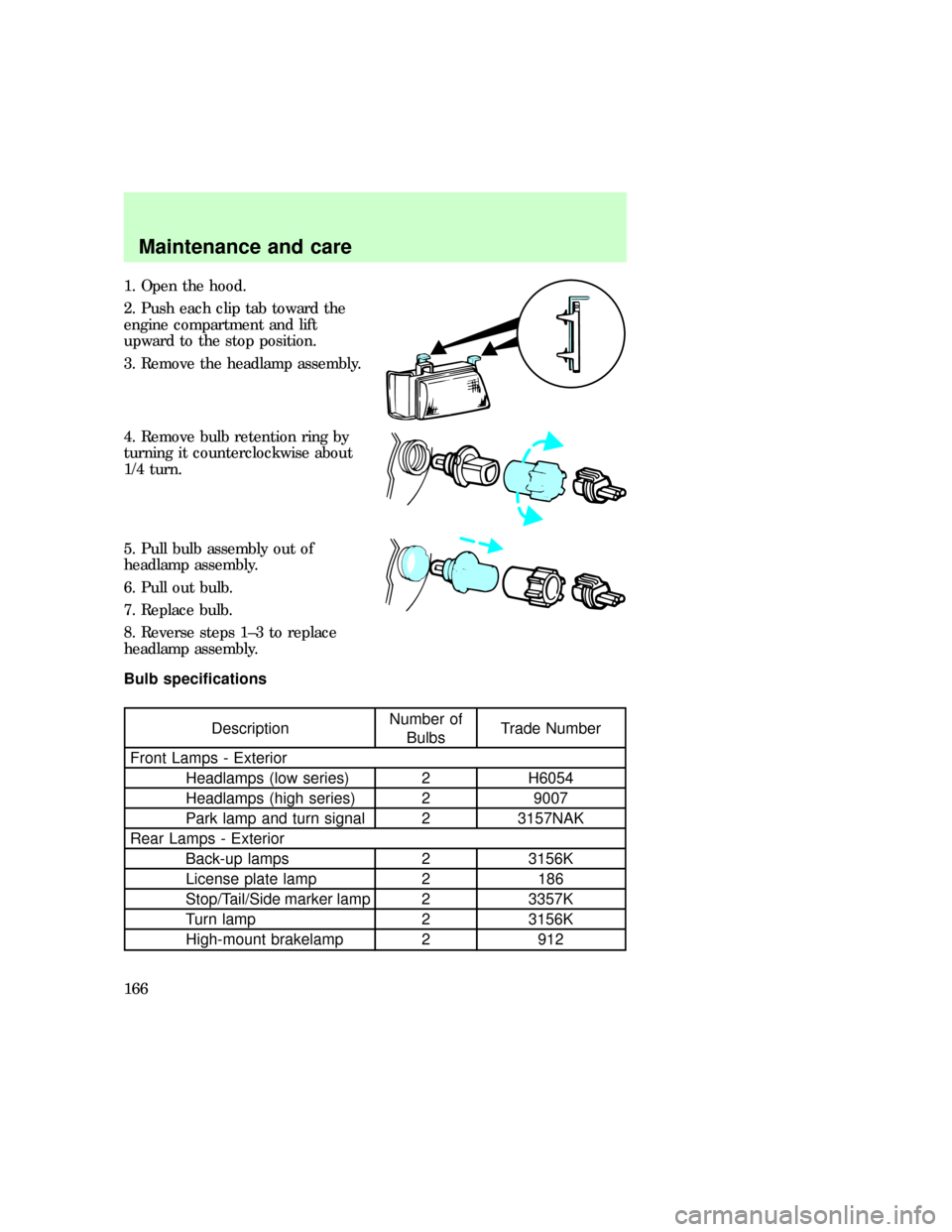
1. Open the hood.
2. Push each clip tab toward the
engine compartment and lift
upward to the stop position.
3. Remove the headlamp assembly.
4. Remove bulb retention ring by
turning it counterclockwise about
1/4 turn.
5. Pull bulb assembly out of
headlamp assembly.
6. Pull out bulb.
7. Replace bulb.
8. Reverse steps 1±3 to replace
headlamp assembly.
Bulb specifications
DescriptionNumber of
BulbsTrade Number
Front Lamps - Exterior
Headlamps (low series) 2 H6054
Headlamps (high series) 2 9007
Park lamp and turn signal 2 3157NAK
Rear Lamps - Exterior
Back-up lamps 2 3156K
License plate lamp 2 186
Stop/Tail/Side marker lamp 2 3357K
Turn lamp 2 3156K
High-mount brakelamp 2 912
eco_bulb_specifications
Maintenance and care
166
Page 167 of 192

DescriptionNumber of
BulbsTrade Number
Interior Courtesy Lamps
Cargo lamp 1 211-2
Dome lamp (standard) 1 912
Instrument panel
illumination2 194
Map/reading lamp 2 211-2
Radio Illumination
1
Instrument Panel
Automatic transmission
gear selector1 194
Instrument Panel Controls
A/C control 1 161
Heater control 1 161
Instrument Cluster
Seat belt light 1 194
High beam indicator 1 194
Brake Warning 1 194
Turn signal indicator 1 194
Anti-lock brake system 1 194
Service engine soon 1 194
Air bag readniness 1 194
Door ajar 1 194
Oil pressure/engine
coolant1 194
1Replaceable at Ford authorized
radio service centers.
NA Ð Natural amber
K Ð Krypton filled bulb
com_cleaning_caring.01
Maintenance and care
167
Page 169 of 192
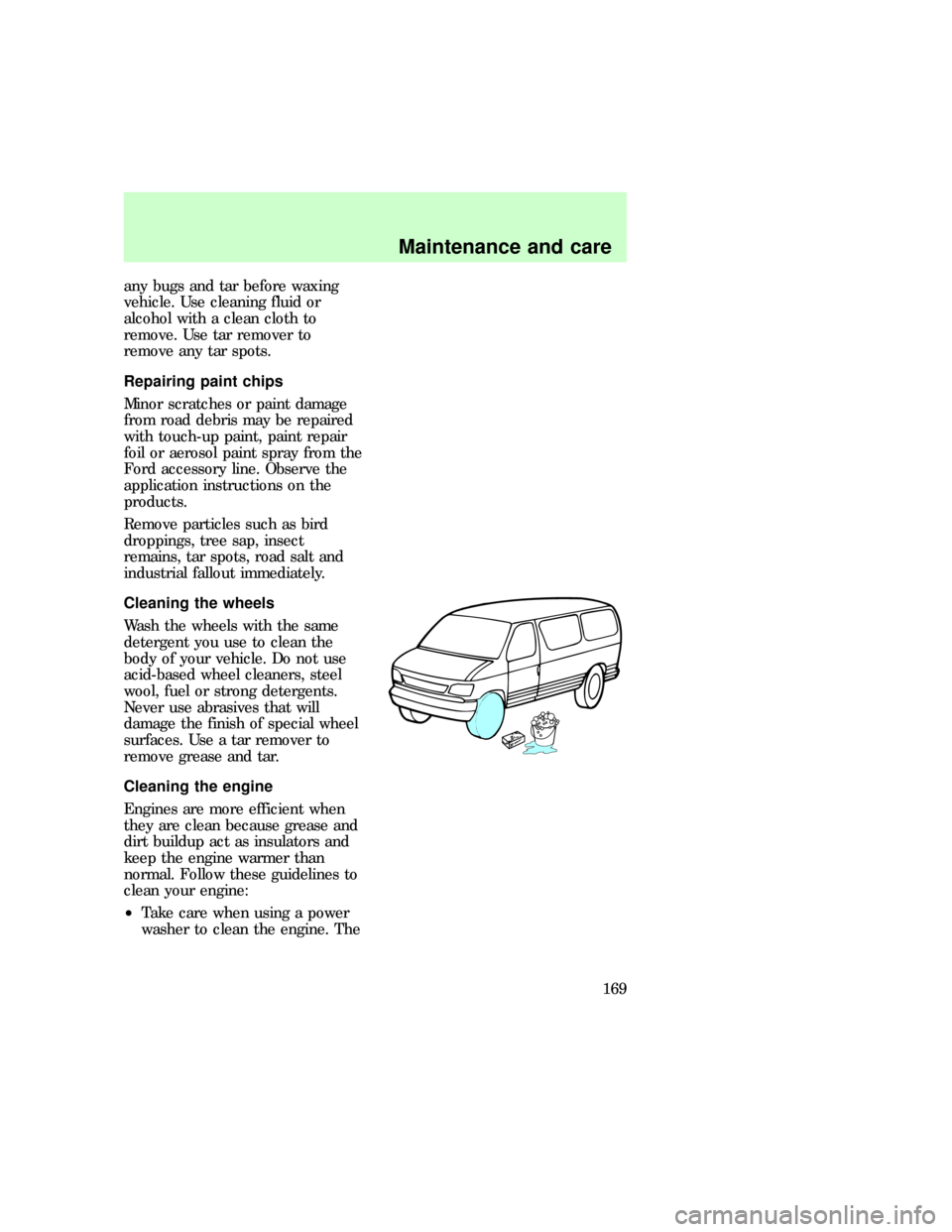
any bugs and tar before waxing
vehicle. Use cleaning fluid or
alcohol with a clean cloth to
remove. Use tar remover to
remove any tar spots.
Repairing paint chips
Minor scratches or paint damage
from road debris may be repaired
with touch-up paint, paint repair
foil or aerosol paint spray from the
Ford accessory line. Observe the
application instructions on the
products.
Remove particles such as bird
droppings, tree sap, insect
remains, tar spots, road salt and
industrial fallout immediately.
Cleaning the wheels
Wash the wheels with the same
detergent you use to clean the
body of your vehicle. Do not use
acid-based wheel cleaners, steel
wool, fuel or strong detergents.
Never use abrasives that will
damage the finish of special wheel
surfaces. Use a tar remover to
remove grease and tar.
Cleaning the engine
Engines are more efficient when
they are clean because grease and
dirt buildup act as insulators and
keep the engine warmer than
normal. Follow these guidelines to
clean your engine:
²Take care when using a power
washer to clean the engine. The
com_repairing_chips
com_wheels_cleaning.01
com_engine_cleaning.01
Maintenance and care
169